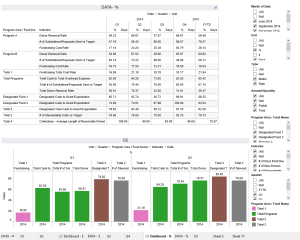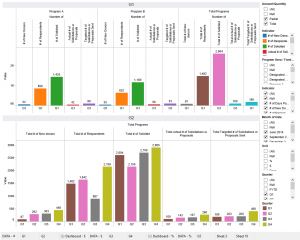The basic organizational elements that inform how for profits and non profits function, evaluate and improve their operations should essentially be the same. Non profits operate as “businesses” with many of the same attributes as for profit organizations – budgets, staffing, governance, planning, accountability to name but a few. Accordingly, non profits can benefit from applying many of the critical tools used by for profit organizations to measure and evaluate performance, and using the results of such analysis to make the required changes to enhance operations.
Technology has provided an array of new analytical tools that can produce timely and accurate reports that measure performance of an organization’s operations against its goals and objectives. The results of such analysis leads to a clearer understanding of how one’s organization is doing in relation to established benchmarks. In turn, the reports produced – in many cases known as “dashboards” – will assist management (and consultants engaged to design and oversee changes) to implement the necessary changes to address the identified issues.
In the charitable world, competition has created challenges for many organizations working in the same sectors to secure financial support to achieve their goals. In order to advance their work, charities have to continually improve on what they do and how they do it. The adoption of business analytics and business intelligence tools does assist charitable organizations to grapple with the challenges they face, and adopt new and varied approaches. After a period of time, the process can be repeated to evaluate, once again, the progress of the changes and make adjustments to operations and strategy.
Consultants who are expert in business analytics work collaboratively with their clients to spearhead excellence and foster the strategic use of data. Through a well devised process and the production of clear and understandable reports, the process of business analytics delivers sustainable business results that address the weaknesses and challenges of the organization.
There are many examples of how business analytics has worked well for a variety of organizations. Here are some examples:
- A financial institution leveraged Data Analytics to enhance informed decision-making.
- Analytics provided a mid-sized retail business with the dashboards and metrics needed to monitor and control cash-flow and gain insights to quickly improve sales and profitability.
- Data Analytics was instrumental for a small business that transitioned to the next level of growth, facilitating performance improvement, financial controlling and brand enhancement.
- An education institution uses dashboards to retain students and grow the market-share.
- Historic and current data visualization permitted a not-for-profit organization understand the problems it faced, paving the way for a successful business transformation and process optimization.
- Analytics provides critical data for a charity on donors, trends, demographics and relation of program initiatives and activities to donations received over reporting periods.
The data gleaned from measurements of an organization’s operations results in a series of charts (dashboards) and report commentary that inform the plans to initiate changes in identified areas such as structure, staffing, financing, marketing, communications, recognition and events.
Here are examples of what dashboards might look like for a donors analysis [click to expand]:
For more information on business analytics and intelligence please contact Mark at manshan@drache.ca or 416-900-5572 x15.

